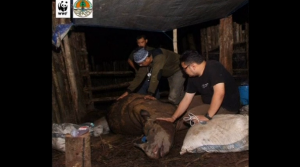
JAKARTA, Indonesia (Reuters) – After four days of treatment, a young Sumatran rhinoceros succumbed to a leg infection in Indonesia on Tuesday (April 5).
Ten year-old female Sumatran rhino, Najaq, died following efforts from environmentalists to keep her alive as she was suffering from an infection.
“It’s because the rhino lived in the wild so we didn’t clearly know the status of its health at that time, but we noticed that she had a wound on her left backfoot caused by wires, which had been there for a long time. So treating her became our main focus when we caught her,” Anwar Purwoto told Reuters.
Najaq was captured alive late last month in Indonesia’s Kalimantan forest on Borneo Island after the first live sighting in the area in 40 years.
World Wildlife Foundation (WWF) said traces of the rhino, which was thought to be extinct in the area, was first recorded on trap camera in October 2013 before it was captured alive.
“Like I said before, we are planning to move all the rhinos from their habitat to the sanctuary, in order to care for them and support their population increase. There are less then 100 rhinos left in Sumatra and Kalimantan,” Purwoto added.
Sumatran rhinos are the smallest rhino species, standing little more than 4 feet (120 centimetres) at the shoulder.
They are the most endangered of all rhinoceros species because of their rapid rate of decline.
Three Sumatran rhinos currently live in captivity in Malaysia’s Sabah state, bordering north of Indonesia’s Kalimantan province. Scientists warned they could be the last species found in the Malaysia jungles.
Efforts to breed the rhinos in captivity have been ongoing in Malaysia since 2012 but it has proved to be a challenging task as the animals are solitary.
Scientists are trying to reproduce embryos in the laboratory, which is now regarded as the a key way to save the species.







